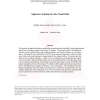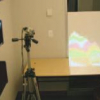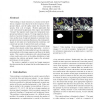CVPR
2004
IEEE
15 years 3 months ago
2004
IEEE
Many computer vision applications have to cope with large dynamic range and changing illumination conditions in the environment. Any attempt to deal with these conditions at the a...
CVPR
2004
IEEE
15 years 3 months ago
2004
IEEE
CVPR
2004
IEEE
15 years 3 months ago
2004
IEEE
A key step for the effective use of local image features (i.e., highly distinctive and robust features) for recognition or image matching is the appropriate grouping of feature ma...
CVPR
2004
IEEE
15 years 3 months ago
2004
IEEE
Semantic scene classification based only on low-level vision cues has had limited success on unconstrained image sets. On the other hand, camera metadata related to capture condit...
CVPR
2004
IEEE
15 years 3 months ago
2004
IEEE
Object classification in far-field video sequences is a challenging problem because of low resolution imagery and projective image distortion. Most existing far-field classificati...
CVPR
2004
IEEE
15 years 3 months ago
2004
IEEE
We present a novel multi-planar display system based on an uncalibrated projector-camera pair. Our system exploits the juxtaposition of planar surfaces in a room to create ad-hoc ...
CVPR
2004
IEEE
15 years 3 months ago
2004
IEEE
This paper explores a formulation for attributed graph matching as an inference problem over a hidden Markov Random Field. We approximate the fully connected model with simpler mo...
CVPR
2004
IEEE
15 years 3 months ago
2004
IEEE
Video matting, or layer extraction, is a classic inverse problem in computer vision that involves the extraction of foreground objects, and the alpha mattes that describe their op...
CVPR
2004
IEEE
15 years 3 months ago
2004
IEEE
In computed tomography, direct inversion of the Radon transform requires more projections than are practical due to constraints in scan time and image accessibility. Therefore, it...
CVPR
2004
IEEE
15 years 3 months ago
2004
IEEE
Many vision tasks can be formulated as partitioning an adjacency graph through optimizing a Bayesian posterior probability p defined on the partition-space. In this paper two appr...




